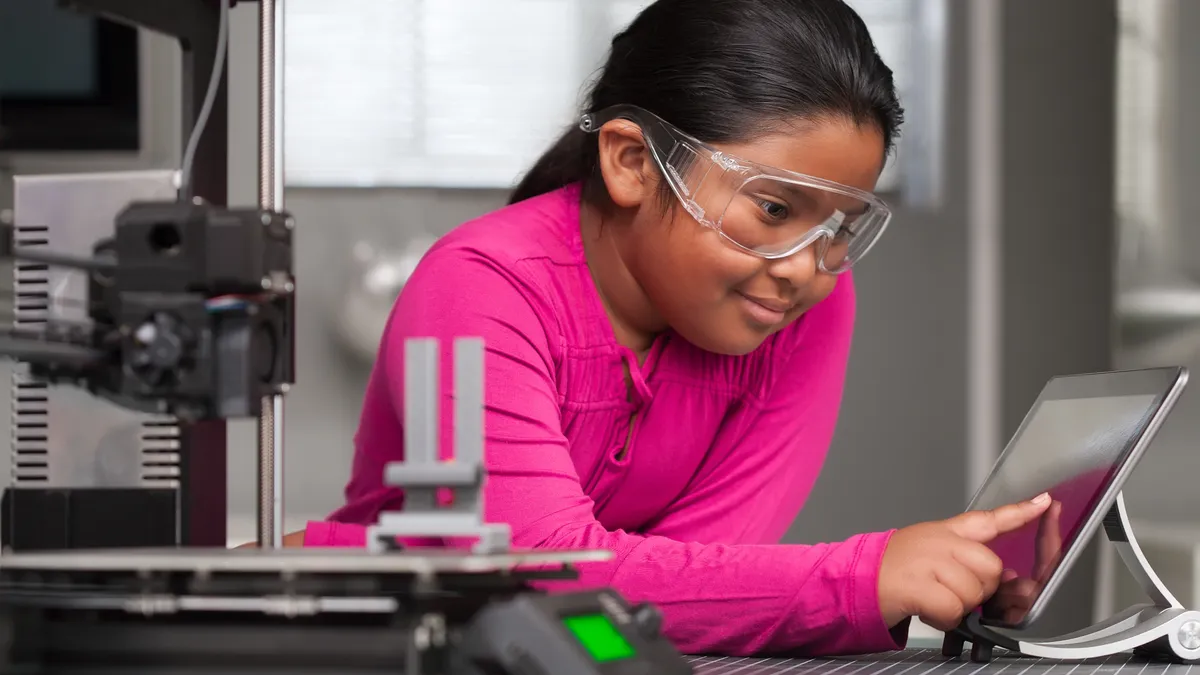Nichole Austion is vice president of public affairs at the National Math and Science Initiative, a nonprofit that strives to advance STEM education for all students.
Whenever I think about my STEM journey, I cannot help but remember a trip to Purdue University during my sophomore year of high school. Walking through a campus with multiple buildings dedicated to engineering pursuits. Watching students and professors work on experiments with real-life implications. Having the chance to participate, however briefly, in their endeavors.

My trip to Purdue University was a defining one. Years later, it still guides my work at the National Math and Science Initiative, because it embodies the impact school culture can have on students’ interest in STEM — especially when those students do not fit typical STEM workforce demographics.
I was one of just a few Black students at my high school — and didn’t have a Black teacher until I went to college — but I did have teachers who noticed my passion for science and channeled it into programs like the one that took me on that Purdue visit.
I wish I could say my sophomore memory is the norm for students today, given the explosive STEM career growth that has occurred in the decades since. Instead, STEM education in the U.S. is at a standstill at best, and regressing at worst, while much of the rest of the world charges forward.
A history of inequities in STEM, combined with lagging advancement in STEM instruction, are troubling realities. Yet there are hundreds of schools across the country already making a difference — paving the way for a brighter future.
Having worked with many of those inspiring schools at NMSI, I wanted to share five components of a school culture that advances high-quality, equitable STEM education.
A STEM-capable mindset
Any meaningful culture shift starts at the top. School leadership must fully embrace the fact that every student has the potential to be successful in STEM. Leadership must spread that mindset outward to teachers, who can instill it in their students.
That may seem like a given, but it is important to acknowledge that decades of conscious and unconscious beliefs about what a successful STEM student “looks like” have impacted teachers’ perceptions of students and students’ perceptions of themselves.
When a Georgia school district saw a decline in AP qualifying scores and enrollment — particularly in STEM subjects — administrators worked with NMSI to make inclusion in AP a priority. Their goal was to dismantle the assumption that students who did not start accelerated classes early had lost the opportunity to participate in advanced learning altogether.
They established an open-door policy for enrolling in Advanced Placement courses and supported it with training for their AP teachers, so they could scaffold students’ foundational gaps while still teaching at the AP level.
Realistic professional development
A school district needs buy in from its administrators and teachers to execute a STEM-capable vision. Buy in requires support that respects the long list of taxing responsibilities educators already have. Realistic professional development has to be worthwhile, integrated and easily sustainable. The leadership at IDEA Public Schools, a public pre-K-12 charter network, understood this when they partnered with NMSI to carry out their “AP for All” initiative.
They started by laying out how professional development will ensure more students from historically under-represented groups will have the opportunity to earn a college degree. Then, they won teachers over with targeted and personalized one-on-one coaching provided by other teachers with different experiences and perspectives.
From there, IDEA and NMSI developed a private training model that gives the schools more autonomy to train teachers in specialized subjects and create flexible PD schedules. In less than 10 years, the commitments from everyone involved have made IDEA schools some of the best in the country.
Industry and community partnerships
Partnerships with local higher learning institutions, industry leaders, workforce development offices and military bases give students real-life context for the importance of STEM. They also give teachers a better understanding of what students need to know to be successful in STEM careers.
Administrators should encourage educators to invite professionals into their classrooms, and make it easy to arrange workplace visits so students can visualize themselves in those positions.
In Knob Noster, Missouri, where 70% of students have connections to Whiteman Air Force Base, the superintendent used a Department of Defense-funded NMSI grant to take the district from one with no AP courses to one that has a robotics team that works directly with Air Force base personnel.
In one instance, students were tasked with designing and testing a switch cover for a B-2 Stealth Bomber cockpit that is now used in actual aircraft. The district has also developed aviation career pathways that allow students to graduate with a pilot’s license.
Commitment to representation
In creating those industry and community partnerships, it is important that all of your students see themselves in the speakers you invite. I implore educators to keep that in mind when planning these kinds of activities.
Take advantage of video conferencing to connect with role models outside your community to bring in a greater variety of experiences. Seeing people of diverse backgrounds excelling in STEM is a powerful precursor to students becoming those people themselves.
You can also keep the diversity of STEM and STEM opportunities at the forefront of students’ minds by literally displaying them throughout your school:
-
Put up images of men and women from different cultural groups who have contributed to STEM.
-
Remind students that they have a myriad of higher education institutions to choose from.
-
Highlight local community colleges and technical programs, historically black colleges and universities, and universities abroad.
-
Display banners throughout the building to show that wherever your students are now, it is just the beginning of their journey.
Fun events that involve family
Lastly, and perhaps most importantly, make STEM fun. Fun lowers the barrier to entry by making seemingly challenging subjects more approachable and exciting without fear of failure. This is particularly important for younger students who are just getting introduced to science and math.
Build STEM events into your school calendar, find ways to support STEM-related clubs, and use summer break to hold STEM camps. These activities create opportunities for students from different grades and backgrounds to learn from each other, which can be more impactful than only learning from their teachers.
It is also worth remembering that some of the parents and guardians in your students’ lives may be intimidated by STEM themselves, so an invitation to school events is a great way to get them involved in your district’s vision.
Children are not born thinking they cannot excel in STEM. It is an idea that builds up over time, but educators and administrators can change the narrative using the time they have with their students.
Those six hours a day are enough to foster an inclusive culture for STEM learning that supports students’ success regardless of their background, zip code or household income. STEM is no longer the future; it is our present, so there’s no time to lose.





 Dive Awards
Dive Awards













